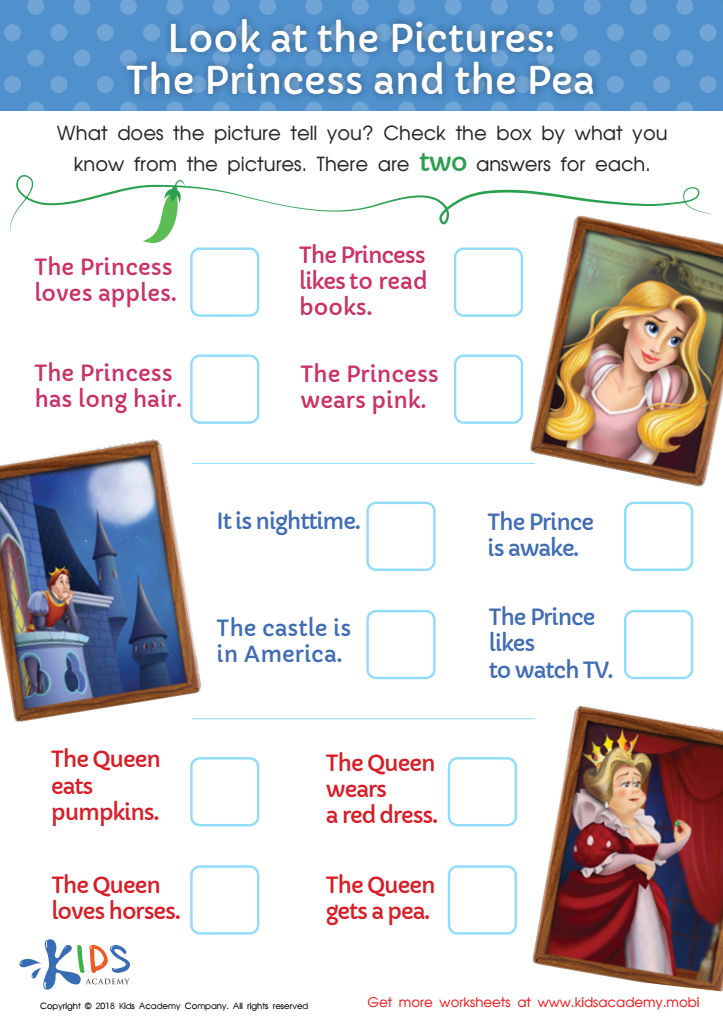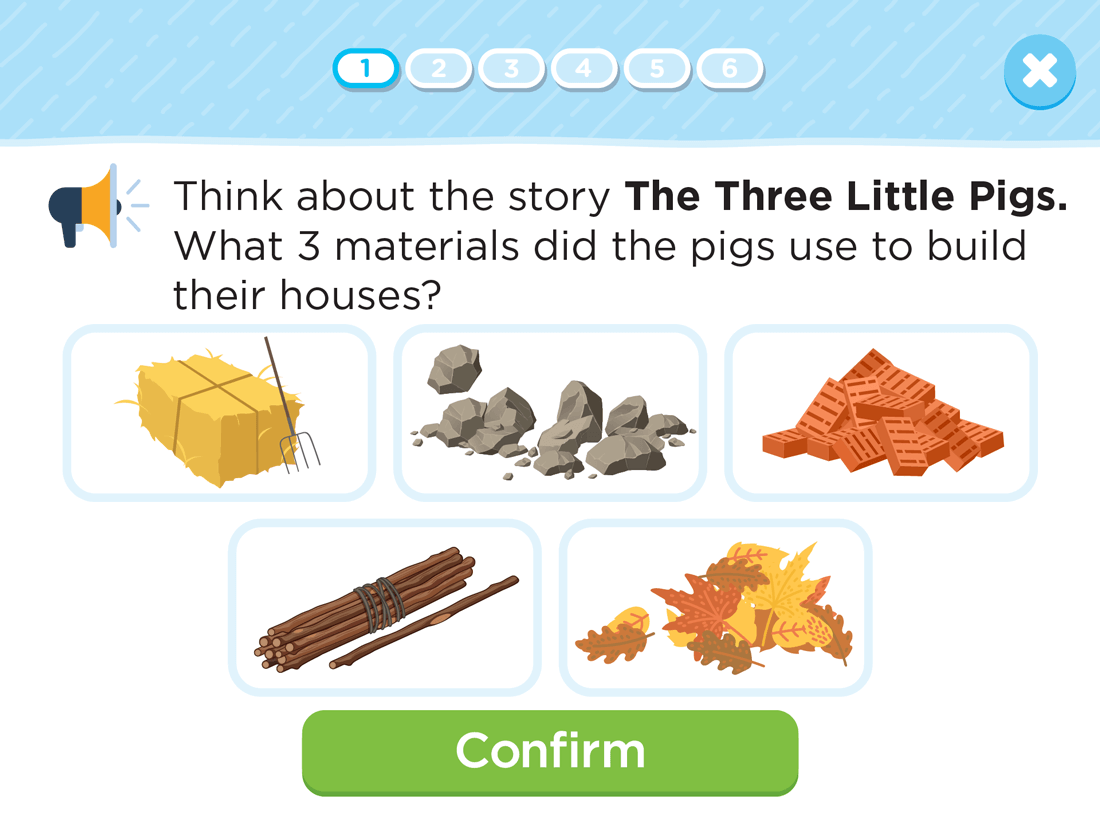
Reading Fiction Essential Activities for Grade 1
Videos
(1/3)
Cinderella | Fairytale
Cinderella is a good classic bedtime story written by Brothers Grimm. This wonderful fairy tail still remains one of the greatest stories for kids ever. See how many chances the prince has to find the girl of his dream. Cinderella is classic fairy tale and good bedtime story for children.
Little Red Riding Hood is a classic bedtime story about little girl and her trip from mother's house to granny. The story revolves around a girl called Little Red Riding Hood. The girl walks through the woods to deliver food to her sickly grandmother.
A Big Bad Wolf wants to eat the girl and the food in the basket. He secretly stalks her behind trees, bushes, shrubs, and patches of little and tall grass. He approaches Little Red Riding Hood, and she naively tells him where she is going. He suggests that the girl pick some flowers, which she does. In the meantime, he goes to the grandmother's house and gains entry by pretending to be the girl. He swallows the grandmother whole and waits for the girl, disguised as the grandma.
"Princess and the Pea" is classic fairy tale written by Hans Christian Andersen gets good old amusement for your kids. Check out what happens when a choosy prince meets a young wonderful girl! Let us know in comments what video you want to see next. Once upon a time there was a prince who wanted to find a princess, but she would have to be a real princess. So he traveled all around the world to find one, but there was always something wrong. There were princesses enough, but he could never be sure that they were real ones. There was always something about them that was not quite right. So he came home again and was sad, for he so much wanted to have a real princess. One evening there was a terrible storm. It thundered and lightninged! The rain poured down! It was horrible! Then there was a knock at the city gate, and the old king went out to open it. A princess was standing outside. But my goodness, how she looked from the rain and the weather! Water ran down from her hair and her clothes. It ran into the toes of her shoes and out at the heels. And yet she said that she was a real princess. "Well, we shall soon find that out," thought the old queen. But she said nothing, went into the bedroom, took off all the bedding and laid a pea on the bottom of the bed. Then she took twenty mattresses and laid them on the pea, and then twenty featherbeds of eiderdown on top of the mattresses. That was where the princess was to sleep for the night. In the morning she was asked how she had slept. "Oh, horribly!" she said. "I hardly closed my eyes all night. Goodness knows what there was in the bed! I was lying on something hard, so that I am black and blue all over my body. It is horrible!" Now they could see that she was a real princess, because she had felt the pea right through the twenty mattresses and the twenty featherbeds. Nobody but a real princess could be that sensitive. So the prince took her for his wife, because now he knew that he had a real princess. And the pea was put in the art gallery where it can still be seen, unless someone has taken it. Now see, that was a real story!
Worksheets
(1/12)
Cinderella Story Sequencing Worksheet

Let’s think about a well-known childhood story and put its events in the correct order to strengthen reading comprehension skills!
This Cinderella story sequencing worksheet will help your child recall key events from this magical story, placing the pictures from the story in the right order.

Being able to infer a character’s traits or feelings is a comprehension skill that is taught so that the reader learns more about the characters and extract more meaning from the text. This aids in the overall comprehension of the story. With this worksheet students read The Boy Who Cried Wolf and then choose the correct emotion for the characters in the story. This printable is a great resource for the reading classroom.

After reading a story, ask your students questions about the events in the text to demonstrate that they understand the story. Having the ability to recall key details after reading is an important comprehension skill. Check your students’ knowledge and understanding of the fairy tale of The Princess and the Pea. After students watch or read the story, answer the questions on this printable.

Recalling and retelling information is a great way to check the comprehension of your young readers. This free worksheet uses colorful illustrations that detail the beloved fairy tale of Little Red Riding Hood and then lets your children use their comprehension skills and strategy to match the illustrations to the correct parts of the story. They'll check off the appropriate boxes as they sequentially order the story, and they'll use the pictures as fun clues.

Picture clues assist early readers in understanding a story or text. Often when reading fiction or an informational selection, students look at pictures and learn the meaning of vocabulary words. Students understand events in a story more clearly with an illustration too. This is a valuable comprehension strategy for early readers. Ask your students to look at this worksheet and see what they learn from looking at each picture from The Princess and Pea.

Recall a favorite fairytale while coloring this captivating printable coloring page: Red Riding Hood! This fabulous scene shows Little Red Riding Hood out in the woods among a butterfly, mushroom, and ladybug.
Your child will love making this fairy tale favorite come to life while coloring!

For children to grow into independent readers as well as critical thinkers, they must be able to understand what they’re reading and the order in which the events occur. That’s why it’s so important to check your child’s comprehension of the sequence of events in a story. Use this brilliant sequencing worksheet from Kids Academy to do exactly that! After reading the classic story about the tortoise and the hare, encourage kids to look at the pictures on this page and put them in the correct order by checking the box next to the correct number for each event!

Summarizing a story is a difficult reading skill for young students. It is challenging because early readers need to be able to distinguish between what details are important and what details are not. This reading worksheet provides practice for readers to identify only the important details from the story of Little Red Riding Hood. Clear up any confusion on summarizing with this downloadable.

Test your child’s reading comprehension with this worksheet: The Boy Who Cried Wolf.
Read the fable with your child, and using the comprehension questions on the page, put your child to the test! Using the text on the worksheet, teach your child how to check answers for correctness.

Read or watch the story of The Princess and the Pea and then use this quick worksheet to test your student’s knowledge of events in the story. Answering the questions of who, what, when and where in a story is a vital comprehension skill and when students recall details, they can begin to work on more advanced comprehension skills such as main idea and theme. Download this printable to use in the school and home classroom.

Most stories have a lesson to learn or a message to share, but kids might need some assistance trying to find it. Use this free downloadable reading worksheet to set your child up for success! To begin, help learners read the story, which features a classic children’s tale that they have probably heard before. Joyful illustrations are included on the page to help young readers visualize the story’s events. To finish, help kids answer the question below by filling in the blank with the phrase that can also serve as the story’s lesson. Check the box next to the correct phrase to complete!

After reading The Boy Who Cried Wolf, test your students understating of the events in the story. When completing the worksheet, students read statements about the story and then decide if the statement is true or false. Completing the worksheet easily checks the student’s ability to recall facts from the story. Check your students’ reading comprehension with this free downloadable.
Quizzes
(1/4)
Answer Questions about Key Details and Unknown Words, and Retell Familiar Stories

In this assessment, students will answer questions about important details and new vocabulary words and retell familiar stories.

In this assessment, students will identify the central message and describe the characters, settings, and major events of familiar stories.

In this assessment, students will answer questions about key details in familiar fairy tales and summarize the stories in sequential order.

In this assessment, students will infer a character’s feelings, identify first and third person point of view, and gather information from illustrations.


